Waterfall methodology vs Agile: What is the difference between Waterfall and Agile
One of the most frequently asked questions in our Certified Scrum Master Class is the difference between Waterfall and Agile.
What is the difference between “Waterfall,” a traditional development method, and “Agile,” which is rapidly being adopted? I would like to explain the differences between each method, mainly the advantages and disadvantages.
 Joe Justice
Joe JusticeWhat you will learn in this article
- Differences between Waterfall and Agile
- Comparison chart between Waterfall and Agile
- Suitability of Waterfall and Agile
- Difference between Waterfall and Agile
- Comparing the Differences between Waterfall and Agile
Differences between Waterfall and Agile methodologies and work processes



The following is a detailed comparison and explanation of the differences between Waterfall and Agile.
- Differences between waterfall and agile methods and work processes
- Differences in dealing with clients (customers) and business partners
- Difference in speed of service delivery
- Difference in flexibility
- Difference in testing frequency
- Difference in process improvement methods and immediacy
- Difference in work process and scope
- Difference in response to specification changes and requirements
Waterfall vs. Agile|Differences in Methodology and Work Process
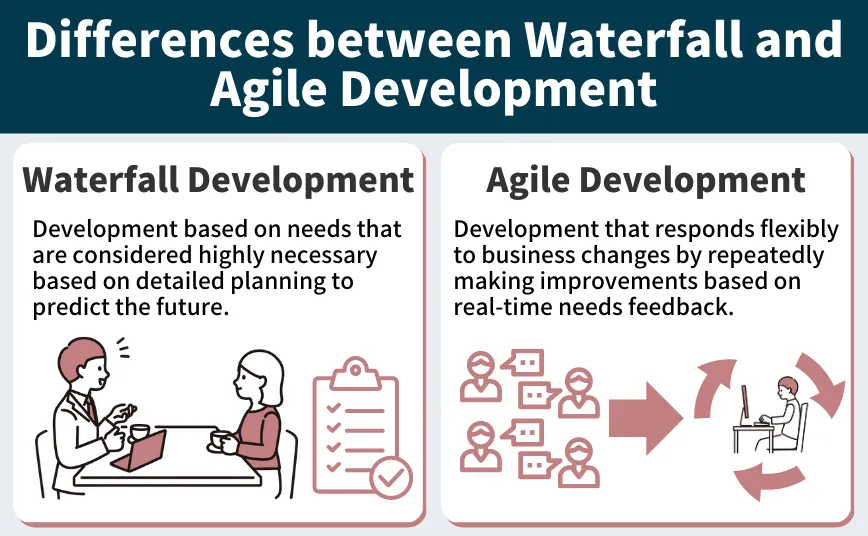

Waterfall has a fixed schedule and budget, and requires careful planning in advance to predict the future. It requires a large product to be completed in a single cycle.
Agile, on the other hand, divides a project into several functions, services, or phases of development. Therefore, improvements are made repeatedly in small units in response to real-time customer needs and feedback, and the project flexibly responds to changes in the business. In other words, a large product is divided into smaller units and completed in multiple cycles in an agile manner.
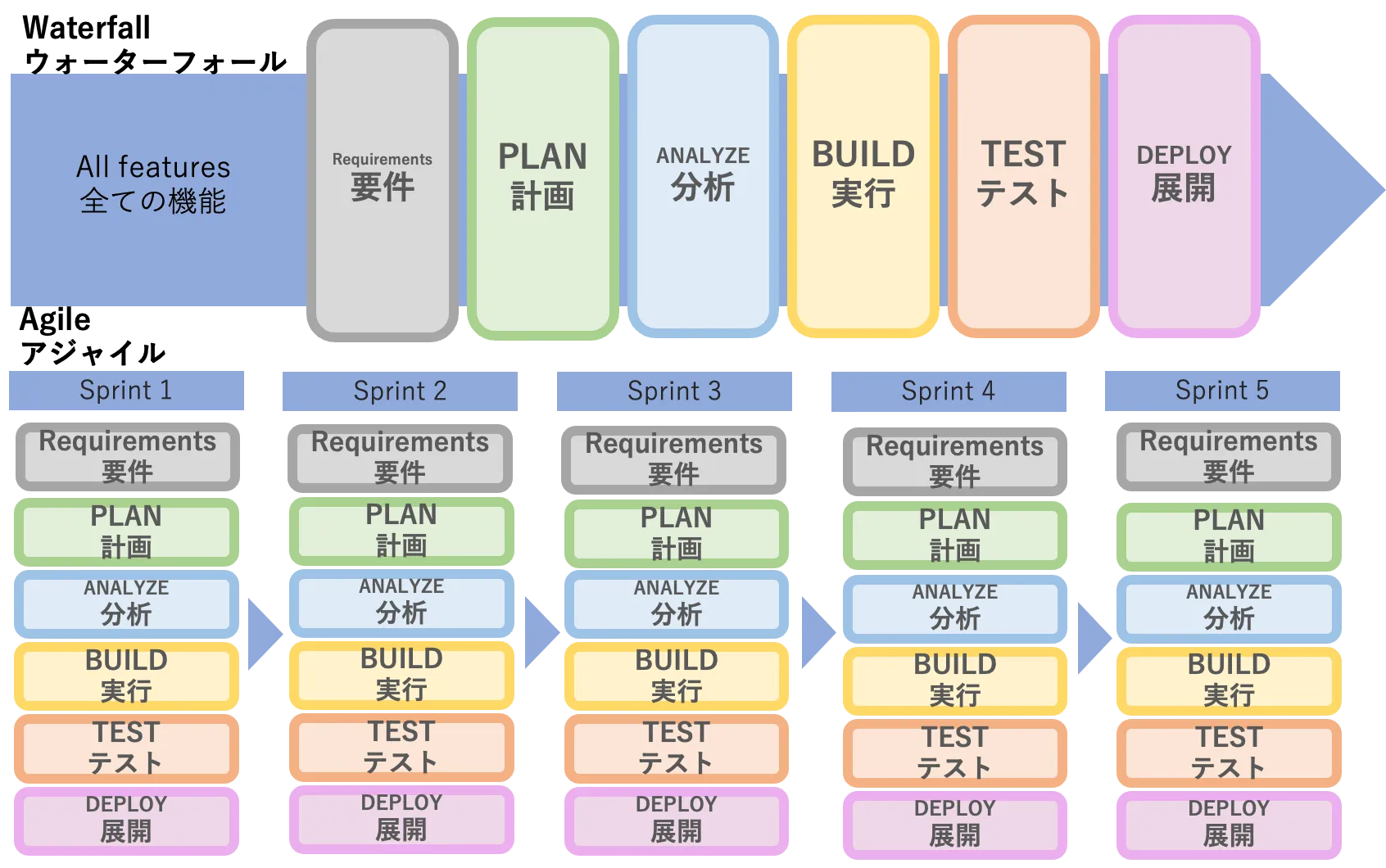

Waterfall Methodology and Work Process
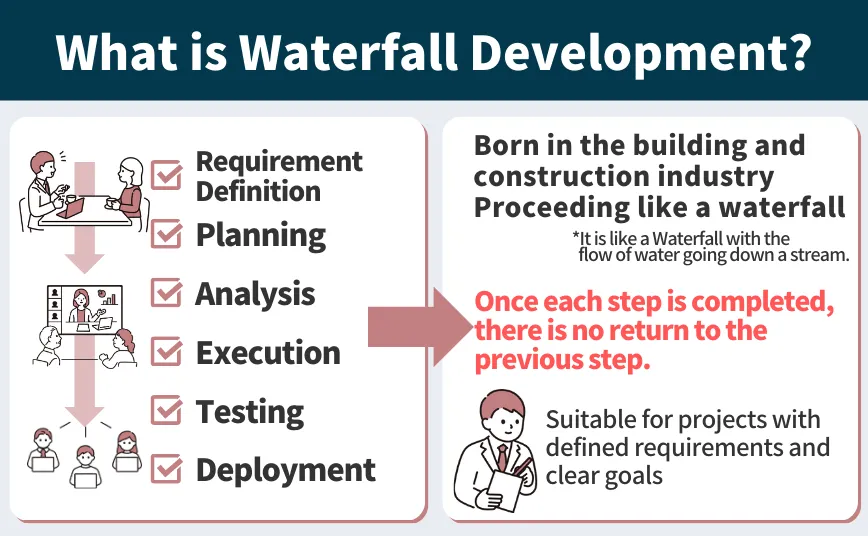

In waterfall, the process of all functions to be developed is divided into “requirements,” “planning,” “design,” “analysis,” “execution,” and “testing. Once a process is completed, it is moved to the next process and there is no going back. Each process is handled by a designated engineer, who prepares documentation for the previous process and passes it on to the next process.
Waterfall is described in detail in the following article.
Agile Methodology and Work Process
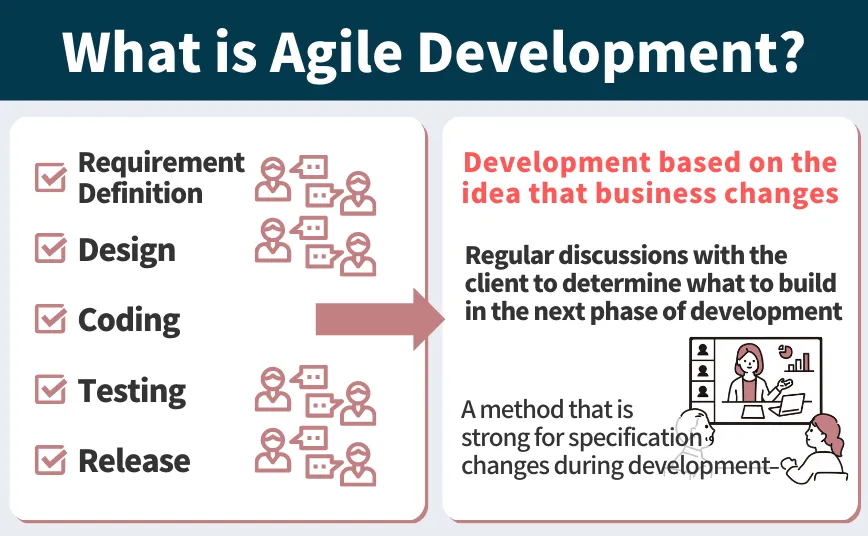

Agile is not a process, but rather, a project is divided by function, service, or stage, and development is repeated in smaller units. All processes are executed within the same team, and each process is not passed on to a different team.
The following article provides a more detailed description of Agile.
Waterfall vs. Agile|Differences in dealing with clients (customers) and business partners
In waterfall development, the client is rarely involved in the project because all the planning is done in advance. However, in recent years, it has become increasingly difficult to plan everything in advance because technology is constantly changing, and clients’ needs evolve with the changes brought about by competitors’ innovations. Therefore, Agile allows us to flexibly respond to customer and stakeholder demands.
Waterfall vs. Agile|Difference in speed of service delivery
Agile prioritizes and divides development into important functions and services or phases, which shortens the time to start using the service. On the other hand, Waterfall tends to take longer to develop because detailed requirements and work schedules for all functions and services are established in advance. And after everything is completed, the service is provided, which is a much longer period of time after the project’s inception.
Waterfall vs. Agile|Differences in Requirements Response and Flexibility
Agile is a more flexible approach because each function is developed separately, and the plan can be changed flexibly according to the situation. On the other hand, Waterfall is less flexible because all work plans are determined in advance and development proceeds according to those plans.
Waterfall vs. Agile|Differences in Testing Frequency
In Agile, a large project is divided into smaller units and development is repeated in smaller units, so testing is performed continuously each time. On the other hand, in Waterfall, the entire development process is decided at the beginning, and testing is performed only during the testing process.
Waterfall vs. Agile|Differences in Process Improvement Methods and Immediacy
In process improvement, in Waterfall, there is basically no return to the previous process, so improvements are identified only after completion. In the case of Agile, improvements can be found in each iteration of development (sprint), and the process can be improved with each sprint.
Waterfall vs. Agile|Differences in Response to Specification Changes and Requirements
In Agile, the customer (client) can request changes or additions to the specifications to the team at any time during the development period. The actual development is discussed with the Agile team, and these are prioritized for development.
In Waterfall, specifications and requirements must be determined prior to development. Therefore, changes from the customer (client) or additions to specifications during the development process are not accepted.
Waterfall vs. Agile|History of the Birth of Waterfall
The waterfall model was born in the manufacturing and construction industries. In a highly structured physical environment, it was considered very costly, if not impossible, to make changes after the fact. Then, a 1956 paper by Herbert D. Bennington and a 1970 paper by Winston W. Royce described the use of phases for software development. This is often said to be the first waterfall model for software, but it is unclear who actually defined “waterfall” and when.
Agile was created in 2001 as a solution to the shortcomings of the waterfall model. The Agile model is designed to flexibly respond to business changes by using a step-by-step approach to complete a product, rather than a process-by-process approach.
Waterfall vs. Agile Comparison Table



Here is a list of the differences between waterfall and agile development and their suitability for different projects.
Please consider which is better suited for your development project.
| Waterfal | Agile | |
| Advantages | Planning is easy Easier to estimate budget and resources Easy to manage progress Simple structure, easy to understand | Rapid deployment Small budget Quick feedback and experimentation Flexible to change |
| Disadvantages | Disadvantages Not flexible enough to handle rework such as specification changes, requirement changes, etc. Difficult to incorporate customer reviews Deliverables take longer to release Timing of testing is at project completion A lot of documents (documentation) are required to be produced | Specification changes/improvements may continue endlessly |
| Suitable | Projects with defined requirements and clear goals | Systems that require planning and development to quickly release and brush up products and services that match user needs |
| Unsuitable | Development in which many changes occur during the development process Projects that do not require change and flexibility | Suitable for projects with defined requirements and clear goals |
| What is emphasized | Development as per requirement definition Strict adherence to schedule Cost sensitivity | Value of deliverables Customer satisfaction |
Agile is best suited for cases where planning and development is required to quickly release products and services that reflect user needs and are continually updated. In order to reflect requests for enhancements and improvements from customers in the service as quickly as possible, additional functions and requests with high priority are reflected from the backlog at a frequency of once per sprint.
Cases where Agile is not suited are projects that do not require change or flexibility.
Distinction between Waterfall and Agile
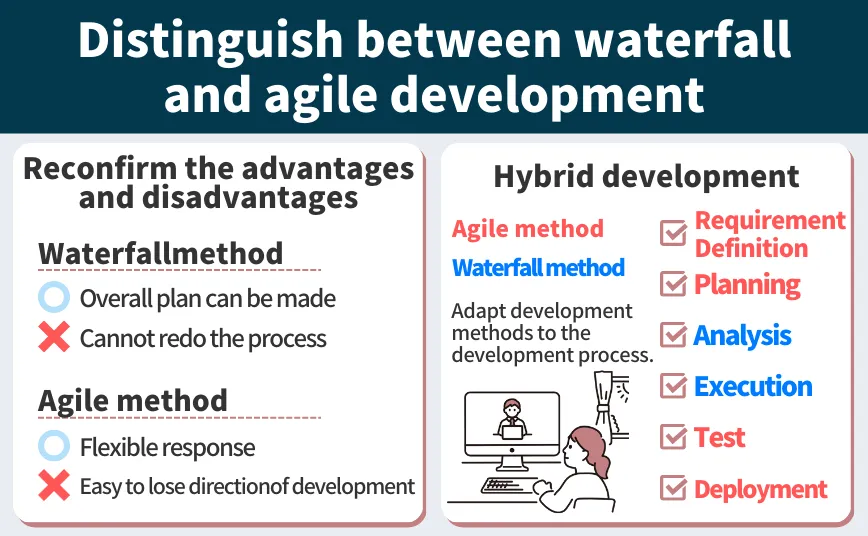

The key word in distinguishing between Waterfall and Agile is “specification change. If the system does not require specification changes, Waterfall may be suitable for the system. If the system is one in which specification changes are possible, then Agile is the right choice.
Reconfirm the advantages and disadvantages of both
Agile was conceived to overcome the disadvantages of Waterfall. In recent years, when Agile is becoming the mainstream development method, Waterfall is sometimes regarded as an old development method. In general, Waterfall is less likely to change after the project starts, and if flexibility to change is not important, Waterfall may be more suitable.
On the other hand, Agile may be more suitable if changes are expected during the development process or if you want to proceed with development while obtaining feedback from users.
Waterfall and Agile require an understanding of the advantages and disadvantages of each development method before deciding on the appropriate development method.
Hybrid Development of Waterfall and Agile
A methodology that uses a combination of waterfall and agile is called hybrid development. In this development method, processes such as requirement definition, basic design, and comprehensive testing are done by waterfall, while detailed design, manufacturing, and unit testing are done by agile. In some cases, companies accustomed to waterfall are adopting this method before moving to full agile.
Hybrid waterfall and agile development is a combination of
Waterfall development
“It is difficult to change specifications and plans.
and “the development period is prolonged due to the large amount of rework.
and “the development period is prolonged” of waterfall development.
In addition, it can compensate for the disadvantages of agile development, such as
The disadvantages of agile development are covered, such as, “The flexibility of agile development makes it easy to lose the direction of development if the initial policy is not checked regularly.
The feature of hybrid development is that it covers the disadvantages of agile development such as “too flexible, but the direction of development can easily become blurred if the initial policy is not checked regularly,” and allows development that takes advantage of the merits of each.
Which is better, Waterfall or Agile?


We asked Joe Justice, a leader in the agile industry, directly!
Which is better, Waterfall or Agile? We also asked him for his advice for those who have experienced failures with Agile, so please refer to it!
- Why is Waterfall moving away from Agile and why is Agile becoming mainstream?
- Do you think there are cases where Waterfall is better than Agile?
- Why Agile fails and advice for those who have experienced Agile failures.
Reasons for the recent move away from Waterfall
- Once a step is completed, it is not possible to go back and make changes to the previous step
- Waterfall methodology relies heavily on initial requirements
- The entire product is only tested at the end
- Planning does not take into account the evolving needs of the client
- Projects are delayed and budgets are affected if new changes are made during the course of the project


Although it is sometimes said that Agile is not suitable for some, it is simply the case that development methods have changed with the changing historical background.
Today, also known as the VUCA era, the business environment is unpredictable and uncertainty is expanding. Therefore, it is necessary to respond flexibly to business changes through an agile approach.
Do you think there are cases where waterfall is better?


Waterfall is over 100 years old.
When I worked with Amazon and Tesla, they mostly used Agile methodologies.
In Japan, I think Agile is new.
Many companies may want a hybrid.
Agile is better to have than not. However, if you implement what you learn in our class, we believe there are no currently known disadvantages to Agile.
Why Agile Fails


Still, some of you may have experienced failures with Agile. Why is that?
There may be multiple reasons, but there may also be issues that you have to overcome as an organization, such as lack of understanding of Agile by the customer (client), contractual issues, lack of delegation of authority, etc.
We can help you solve this, and we also offer Advanced Certified Scrum Master and classes for upper management and clients.
Agile is very good, but it is not magic and will not transform your organization in a day. Let’s innovate together so we can continue to transform individuals, teams, and organizations on an ongoing basis!
Conclusion
We have explained the difference between Waterfall and Agile, their suitability and usage, and hybrid development. We hope that you will understand the suitability of each type of development, and then adopt Agile as well.
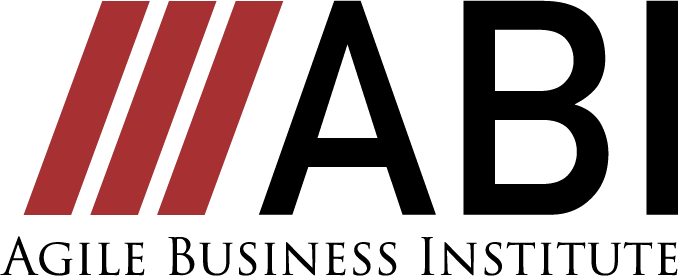
コメント